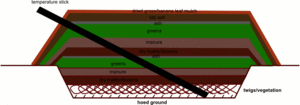
There are many ways to build a good compost. This page shows a method that comes from a rural, developing world perspective, although it could easily be used or adapted elsewhere.
The aim is to build a quick decomposing hot compost that is made from locally available materials, which can easily be gathered and built in a rural setting.
The work in building a large compost is often shared amongst a number of people, with the final compost being used by each one when appropriate
Ways of building compost[edit | edit source]
The method of building compost can be different depending on the amount of compost required, materials available, type of compost and particularly the climate of the region.
Pit Compost[edit | edit source]
Pit compost is ideal for areas with medium to low rainfall. The depth of the pit will depend upon the amount of rainfall. The less the rainfall the deeper the pit should be to prevent the rapid loss of water, which is essential in the natural production of compost. In some dry regions it has been known for pits to be dug as deep as 3ft. For example, this type of compost is used in the dryer and warmer parts of central and northern Uganda
Heap Compost[edit | edit source]
Probably the best way of making vegetation compost in areas of heavy and frequent rainfall. A farmer does not need to build a deep pit to build this type of compost. In regions of heavy rainfall, water would remain standing in a pit resulting in an inadequate flow of nutrients and the production of peat rather than compost. For example, this type is used in the temperate mountainous regions of eastern Uganda and western Kenya
Trench Compost[edit | edit source]
This involves the building of the compost for convenience close to where it is needed or the source raw materials
Boma compost[edit | edit source]
This takes place where animals are kept. Making compost from the bedding, manure and urine.
Basket Compost[edit | edit source]
Materials and Requirements[edit | edit source]
|
Some materials are not good composting materials as they inhibit the natural processes
|
Method[edit | edit source]
Preparation[edit | edit source]
- Select a site to be used for composting. Compost best composes in moist or damp conditions. The best site is a place that which is sheltered from wind, rain and sun, in a shady spot, preferably under a tree. Placing the site on a slight slope can be useful to improve drainage
- Measure an area for the compost. A good size is 4ft x 4ft as it is a good size but allows room to work on the compost pile
- For places of heavy rainfall - build the heap compost on the ground surface. Begin by loosening the ground and sprinkling water on the surface. This allows better passing of nutrients and moisture between the ground and the heap
- For paces of low rainfall - dig a pit 2-3ft deep. Loosen the ground at the bottom and sprinkle with water. The top soil from the digging can be put aside to be used later in the compost
Building[edit | edit source]
See diagram for visual guide
- Lay down the rough materials - e.g small twigs, maize or sorgum stalks. About 1ft of these (unslashed) will allow free air and water movement at the base of the compost
- Sprinkle water - Add a liberal amount water between each layer, but ensure it is sprinkled. This will give the compost adequate and even spread of moisture. It is sprinkled to achieve an evenly watered moist compost (as opposed to a wet one)
- Lay down the brown material - e.g dry vegetation, soft tree leaves, dry grass, cut dried banana leaves. This layer should be about 4ins
- Lay down a layer of manure - e.g Poultry, Pig, Goat, cow
- Sprinkle a thin layer of top garden soil, old compost and water. This rich layer will already containing rich nutrients, and hence will kick start the process
- Add a layer of green material and sprinkle ash (do not water this layer). The ash neutralizes the acidity of the greens and aids decomposition through its salts
- Repeat the layers 3-6 described above until the compost reaches hip height from the ground or knee height from the pit
- The last layer is a thick layer of topsoil which is then generously sprinkled with water
- The compost is well mulched all around with dried grass, banana leaves or twigs. This prevents moisture from escaping from the compost
- A long sharp ended stick is inserted through all the layers. This can be user as a thermometer to analyze how the compost is progressing
Monitoring[edit | edit source]
- After 3 days take out the long stick to see if decomposition has started. The stick should be noticeably warmer at the centre of the stick. If not, then add more water. It may be too dry.
- Use the stick as a thermometer, and regularly check the heat of the compost. Add water if it is too dry, or there is noticeable mould forming on the stick
- Remove the mulch and turn the whole compost every 3 weeks. Then put the mulch over the top layer again
- Given good conditions, the compost can be ready as soon as nine weeks. When ready, the soil should be moist, smell fresh and have a sweet forest smell
Uses of compost[edit | edit source]
- Nursery bed establishment
- Potting for seedlings, vegetables or trees
- Mix in with garden soil to improve conditioning
- Use in Double digging for high yield vegetable beds
- If used in transplanting seedlings to the soil it improves the chances of survival and speed, size of growth
- Can be sold to other farmers